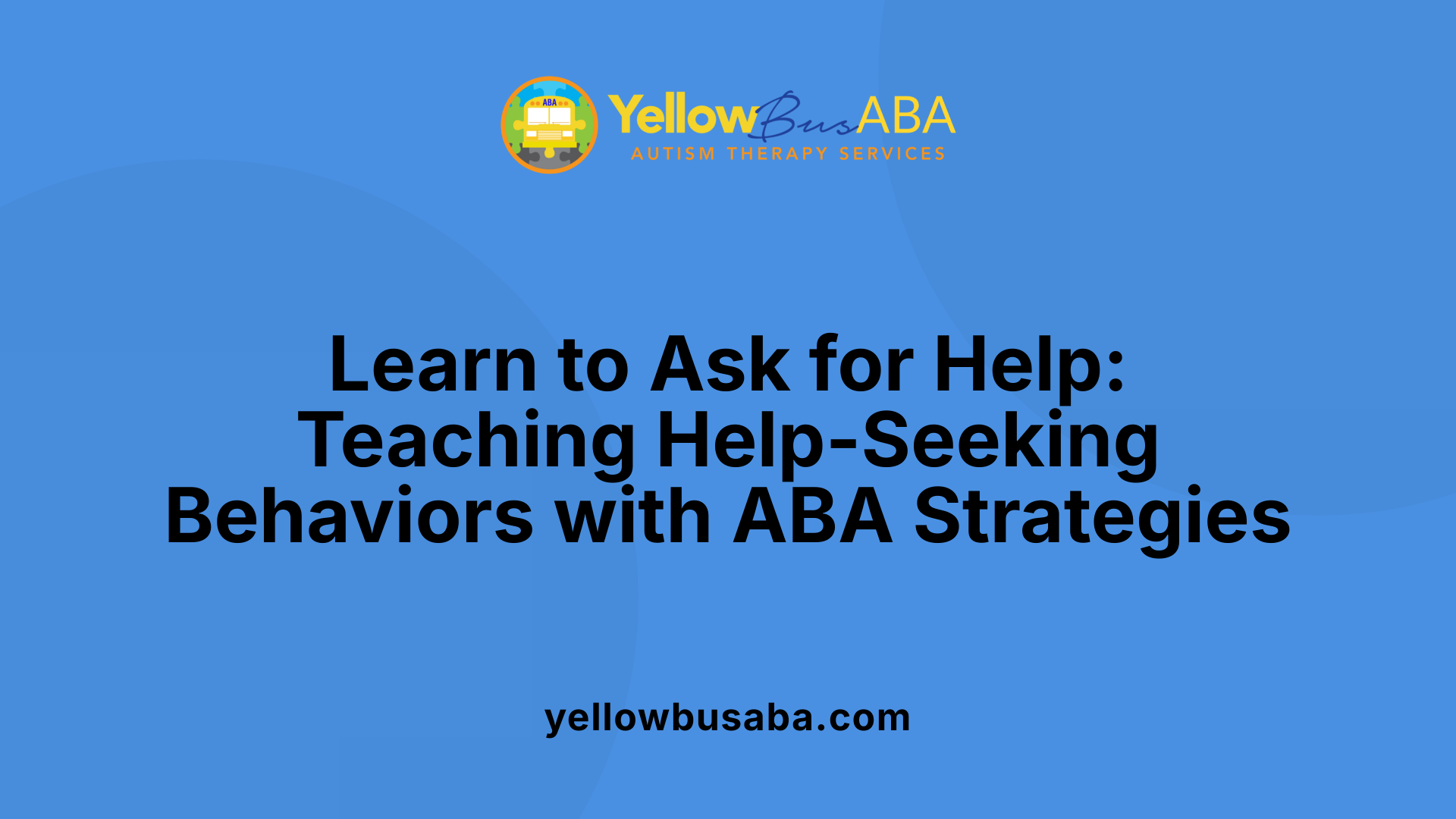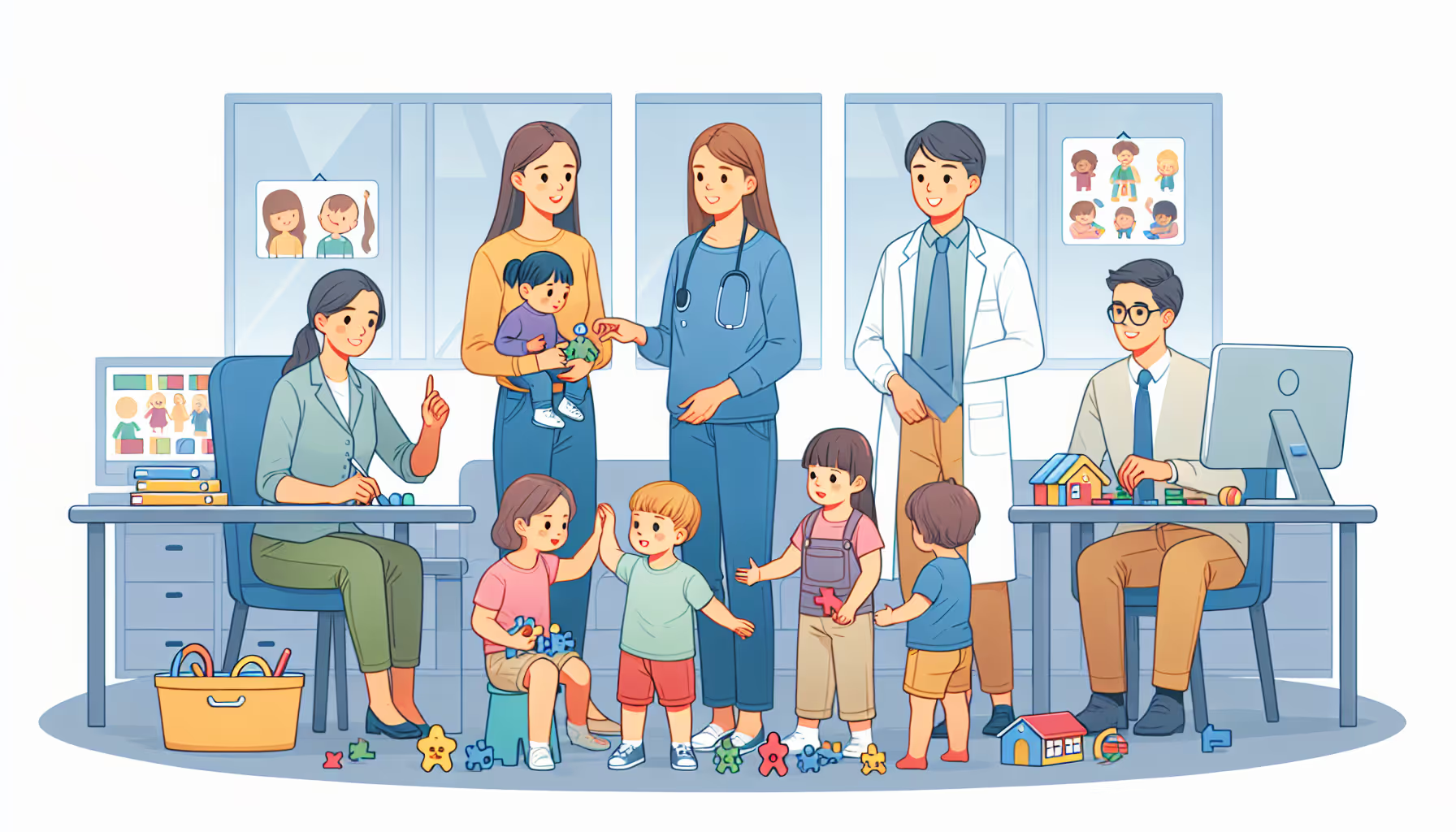The Role of ABA Therapy in Teaching Children to Ask for Help
September 15, 2025
Empowering Independence: How ABA Therapy Teaches Children to Seek Help

Understanding the Impact of ABA in Developing Help-Seeking Skills
Applied Behavior Analysis (ABA) therapy is a scientifically supported method that plays a crucial role in teaching children with autism how to effectively ask for help. By integrating various techniques rooted in the science of learning and behavior, ABA facilitates the development of essential social and communication skills, enabling children to navigate their environments more confidently and independently.
Core Principles and Techniques of ABA Therapy

Understanding ABA as a science of behavior and environment
Applied Behavior Analysis (ABA) is a scientific approach that focuses on understanding how behavior is influenced by the surrounding environment. It emphasizes the relationship between specific behaviors and environmental factors, allowing practitioners to develop targeted interventions to promote positive changes. By analyzing antecedents (what happens before a behavior) and consequences (what happens after), ABA helps identify ways to increase helpful behaviors and reduce problematic ones.
Principles of learning applied in ABA, such as reinforcement, prompting, and modeling
ABA employs fundamental learning principles, with positive reinforcement being one of the most powerful tools. When a behavior is followed by a reward, the likelihood of that behavior recurring increases. Prompting involves providing cues or hints to encourage a desired response, which is gradually faded to promote independence. Modeling demonstrates the behavior by an adult or peer, allowing the child to imitate. These techniques are combined to create effective, individualized teaching strategies.
Specific techniques like discrete trial training, natural environment training, task analysis, and chaining
ABA therapists utilize various methods tailored to each child's needs. Discrete Trial Training (DTT) offers structured learning by breaking skills into small, manageable steps, with clear prompts and reinforcement. Natural Environment Training (NET) teaches skills in everyday settings, promoting generalization. Task analysis involves dissecting complex skills into simple components for easier learning. Chaining strings these components together into a cohesive skill, ensuring each step is mastered before moving on. These techniques collectively promote skill acquisition across communication, social, and daily living domains.
Strategies to teach help-seeking behaviors
Teaching children to ask for help involves several structured techniques. Prompting, such as providing visual cues or verbal hints, encourages the child to perform the help-seeking behavior. Positive reinforcement, like praise or tangible rewards, strengthens this response. Visual modeling through pictures or videos demonstrates how to ask for assistance, fostering imitation. Role-playing and scripted scenarios allow children to practice asking for help in a safe environment, with prompts gradually reduced to foster independence. Functional Communication Training (FCT) explicitly teaches appropriate ways to seek help when needed. Through these methods, children learn to effectively communicate their needs, which can generalize to real-world situations.
Assessment and Goal Setting in ABA

How do practitioners conduct assessments to identify social skill deficits?
In ABA therapy, professionals start by conducting detailed assessments, such as functional behavior assessments (FBAs). These evaluations analyze a child's current skills and behaviors to identify areas needing improvement. Practitioners observe children in different settings, gather data, and pinpoint specific weaknesses—like difficulty making eye contact or engaging in reciprocal communication.
Once the assessment is complete, the team determines which social skills the child needs to develop. This step helps ensure that therapy targets relevant and impactful behaviors.
How are measurable and achievable goals set based on a child's needs?
Goals are crafted to be clear, specific, and attainable. For example, a goal might be for a child to ask for help when lost in a store, with measurable criteria such as doing so consistently in three different situations.
Goals are tailored to each child's unique profile, considering their strengths, challenges, and interests. Setting realistic milestones helps track progress and keeps therapy focused on meaningful improvements.
How are individualized therapy plans developed and overseen?
Developed by Board Certified Behavior Analysts (BCBAs), these plans incorporate the assessment results and establish a structured approach to teaching social skills. The plans specify techniques like prompting, modeling, reinforcement, and natural environment teaching.
Therapy plans are dynamic, with regular data collection to assess effectiveness. Adjustments are made based on the child's progress, ensuring personalized and flexible intervention. This tailored approach maximizes the child's potential for developing essential social and communication skills.
Teaching Social Skills and Communication through ABA
Techniques like role-playing, social stories, modeling, peer-mediated interventions, video modeling, and prompts
Applied Behavior Analysis (ABA) uses a variety of effective strategies to help children develop essential social and communication skills. One common technique is role-playing, where children practice social interactions in a safe, controlled environment, allowing them to learn appropriate responses and behaviors.
Social stories are another useful tool. These are short, visual stories that illustrate social situations and proper responses, helping children understand what to do in specific scenarios. This method is particularly effective for teaching complex social concepts in an understandable way.
Modeling involves demonstrating desired behaviors for children to imitate. Whether it’s making eye contact or sharing, therapists show the behaviors, and children are encouraged to copy them. Peer-mediated interventions promote social skills by involving classmates or peers in structured activities, fostering natural social interactions.
Video modeling is a technology-based technique where children watch videos demonstrating targeted social behaviors and then practice them. This method provides visual and consistent examples that children can revisit as needed.
Prompts and fading are integral parts of ABA. Prompts are cues or assistance provided to help a child perform a skill. Over time, prompts are gradually removed through fading strategies, encouraging independent skill use.
All these methods work together within personalized ABA programs to systematically teach children how to interact effectively with others. They lay the groundwork for behaviors like taking turns, sharing responsibilities, and understanding social cues, fostering meaningful connections and enhancing overall social functioning.
Developing Verbal and Non-Verbal Communication Skills
Building verbal skills, including requesting and initiating conversations
ABA therapy plays a vital role in helping children develop strong verbal communication abilities. One effective approach is Verbal Behavior Therapy (VBT), which categorizes language into operants such as mands (requests), tacts (labels or comments), echoics (repeating sounds or words), and intraverbals (conversational exchanges). Through structured techniques like discrete trial training (DTT) and natural environment training, therapists teach children how to initiate conversations, ask for help, and respond appropriately in social settings.
Reinforcement strategies are used to encourage the use of words and phrases. For example, when a child requests an item or help, they are praised or rewarded, making it more likely they will use such language again. Over time, children learn to expand their vocabulary and comfortably request what they need.
Enhancing non-verbal skills like eye contact, understanding body language, and gestures
Non-verbal communication is equally essential for meaningful social interactions. ABA therapy targets skills such as making eye contact, recognizing facial expressions, using gestures, and understanding body language. Specific interventions, including modeling, role-playing, and video modeling, help children interpret and produce non-verbal cues.
Therapists also incorporate social stories and natural environment teaching to guide children in recognizing social cues like the tone of voice or facial expressions. These activities help children respond appropriately, which is crucial for forming friendships and interacting confidently.
Use of Verbal Behavior Therapy (VBT) including mands, tacts, echoics, and intraverbals
VBT emphasizes functional language skills by addressing different types of verbal operants. Mands involve requesting or asking for desired items or help, which teaches children to communicate needs effectively. Tacts are labels or comments about objects or events in their environment, fostering vocabulary development.
Echoics focus on repeating sounds or words, helpful for phonetic development, while intraverbals are conversational exchanges that promote back-and-forth interaction.
Children often receive targeted training in these areas through prompting, shaping, and fading techniques. This systematic approach ensures they acquire practical communication skills that support their social and academic growth.
A combination of structured teaching and naturalistic strategies allows children with autism to develop both verbal and non-verbal communication, fundamental for building relationships, participating in everyday activities, and gaining independence.
Teaching Help-Seeking and Social Cues Recognition

How does ABA therapy help children with autism learn to ask for help?
ABA therapy plays a vital role in teaching children with autism to ask for help by focusing on developing functional communication skills. The approach involves tailored, step-by-step procedures that promote understanding and independence.
Therapists often use prompting and modeling techniques to demonstrate how to ask for assistance, such as saying "What is this?" or "Where is that?" during relevant activities. These prompts are gradually faded over time, encouraging the child to initiate requests on their own. Reinforcement, such as praise or tokens, motivates children to practice these new skills.
Creating specific situations and environments is also a core part of the process. For example, a child might be placed in a scenario where they are likely to need help, motivating them to seek guidance. The consistency of reinforcement helps solidify the behavior, making asking for help a natural part of their interactions.
Additionally, ABA relies on understanding the ABC model — Antecedent, Behavior, and Consequence. Recognizing what triggers a help-seeking behavior (antecedent), the behavior itself, and the reward or response (consequence) helps therapists fine-tune strategies to reinforce positive communication.
Through structured and personalized programs, ABA teaches children to recognize social cues such as facial expressions and tone of voice. Finding the motivation in these cues, children learn to respond appropriately, making help-seeking behaviors a habit that supports their safety and independence.
In summary, ABA therapy systematically teaches children to communicate their needs effectively. These skills enhance their ability to seek help when needed, build confidence, and navigate social environments more comfortably.
Generalization of Help-Seeking Behaviors to Real-Life Settings
How can ABA therapy prepare children to seek assistance in real-life situations?
ABA therapy plays a vital role in teaching children with autism to ask for help in everyday environments such as home, school, and community settings. Therapists use structured, individualized techniques like role-playing, natural environment training, and positive reinforcement to foster these skills.
In therapy sessions, children practice scenarios that simulate real-life situations where help might be needed, such as getting lost in a store or feeling overwhelmed at school. Role-playing allows children to rehearse asking for assistance in a safe space, which helps them transfer these skills into actual environments.
Natural environment training (NET) emphasizes teaching in the child's typical surroundings, making the practice more relevant and effective. Reinforcement strategies reward children when they successfully seek help, encouraging them to repeat the behavior.
Consistent practice and reinforcement across various settings help children generalize their help-seeking skills beyond therapy. This means they start recognizing situations where help is needed and confidently ask for it, promoting increased independence.
Beyond communication, ABA also focuses on emotional regulation, understanding social cues, and managing transitions—all of which support children in feeling safe and willing to seek help when necessary.
Importantly, ongoing assessments and data collection are crucial. These tools help therapists track progress, identify what strategies work best, and tailor interventions to each child's needs.
By systematically applying these methods, ABA therapy effectively prepares children to navigate their daily lives more independently and confidently, ensuring they know how and when to seek help in various situations.
Benefits of ABA in Enhancing Social and Communication Skills
How does ABA therapy improve social interaction and communication skills?
ABA therapy focuses on systematically teaching children social and communication skills through evidence-based techniques. It helps children develop both verbal and non-verbal communication, such as making eye contact, understanding body language, and asking for help. ABA practitioners use methods like discrete trial training, natural environment teaching, and modeling to teach these skills step-by-step.
One significant aspect of ABA is the use of reinforcement strategies. When children demonstrate desired behaviors, such as initiating a request or responding to social cues, they receive praise or tangible rewards. This positive feedback encourages them to repeat these behaviors and gradually become more natural in social interactions.
ABA also incorporates specialized approaches like Verbal Behavior Therapy (VBT), which categorizes language into operants like mands (requests), tacts (labeling), and intraverbals (conversational exchanges). This helps children understand how to express their needs and engage in reciprocal conversations.
How does ABA therapy strengthen relationships with family and peers?
By teaching essential social skills, ABA therapy helps children build meaningful connections with family members and peers. Skills such as taking turns, sharing, respecting boundaries, and working collaboratively are integral parts of the therapy.
Through role-playing, social stories, peer-mediated interventions, and in natural settings, children learn to recognize social cues like facial expressions and tone of voice. These skills enable them to participate more fully in social activities and develop friendships.
Structured play and activities are used to provide safe environments for practicing social interactions, helping children feel more confident and less anxious in social settings.
How does ABA therapy contribute to reducing challenging behaviors related to communication?
Many children with autism exhibit challenging behaviors due to communication difficulties. ABA addresses this by teaching functional communication skills through techniques like Functional Communication Training (FCT). This approach replaces problematic behaviors, such as tantrums or aggression, with appropriate ways to ask for help or express needs.
Consistent, individualized training enables children to understand and respond to social cues appropriately. As their communication improves, their frustration levels decrease, leading to fewer challenging behaviors.
How does ABA support children’s independence and confidence?
ABA therapy promotes independence by teaching children daily routines, self-care skills, and adaptive behaviors. Skills such as requesting assistance, following instructions, and self-regulation are systematically developed.
Using visual schedules, countdown timers, and role-playing, children learn to manage transitions and handle change, reducing anxiety.
Improved communication and social skills foster a sense of achievement and self-confidence. As children become more capable of navigating social environments and expressing their needs, they gain autonomy and a stronger sense of self-efficacy.
| Aspect | Skills Developed | Techniques Used | Outcomes |
|---|---|---|---|
| Social Interaction | Turn-taking, sharing, respecting boundaries, working with others | Role-playing, social stories, peer interventions | Better peer and family relationships |
| Communication Skills | Requesting help, understanding cues, initiating conversations | VBT, prompting, modeling, natural teaching | Enhanced verbal/non-verbal communication, independence |
| Reducing Challenging Behaviors | Replacing tantrums with functional requests | FCT, reinforcement strategies | Decreased problem behaviors, increased adaptive responses |
ABA therapy offers a comprehensive approach to developing essential social and communication skills. Through personalized interventions, children gain confidence, form stronger relationships, and improve their ability to navigate social environments effectively.
Building Foundations for Independence and Safety Skills
Promoting independence in daily routines (dressing, brushing teeth, eating)
ABA therapy plays a vital role in helping children with autism develop self-care skills that foster independence. Therapists break down complex routines like dressing, brushing teeth, and eating into small, manageable steps. Using techniques such as chaining, shaping, and reinforcement, children learn each step gradually. For example, a child might first learn to pick out clothes, then put on a shirt, followed by buttoning or zipping.
Consistent routines, visual cues like schedules, and positive reinforcement motivate children to practice these daily activities. Over time, children gain confidence and can perform these routines with minimal support, promoting their independence and self-esteem.
Teaching safety skills such as help-seeking behaviors and understanding social cues
Safety is paramount, and ABA therapy emphasizes teaching children how to seek help in various situations. For instance, children are taught to ask store employees for assistance if they are lost or need support. Therapists use role-playing, social stories, and reinforcement to teach these behaviors.
Understanding social cues, such as facial expressions, body language, and tone of voice, helps children recognize when someone needs help or when someone is upset. These skills are explicitly taught through modeling, social stories, and video modeling, making children more attentive to their environment.
Supporting emotional regulation and stress management
Children with autism often face challenges in managing emotions and stress. ABA programs include strategies for recognition and regulation of feelings. Techniques like visual aids, countdown timers, and calming routines help children understand their emotions and develop coping skills.
Through practice and reinforcement, children learn to self-regulate, which enhances their ability to handle transitions, reduce anxiety, and respond appropriately in social situations. These skills are crucial for building resilience and ensuring children can navigate daily life safely and confidently.
Ongoing Family and Caregiver Involvement
Active involvement of families and caregivers is essential to the success of ABA therapy for children with autism. Training caregivers to reinforce skills at home helps ensure that children can practice and maintain social and communication skills beyond therapy sessions.
Therapists provide families with resources, strategies, and guidance on how to integrate learned behaviors into daily routines. This might include using visual aids, following consistent rules, and applying positive reinforcement techniques in everyday settings.
Collaborating closely with families allows for consistent practice and supports skill generalization across different environments, like home, school, and community. Regular communication between therapists and caregivers ensures that everyone stays informed about progress and adjusts strategies as needed.
By actively participating, families can significantly enhance the child's development, making therapy a cohesive and effective process.
| Strategy | Description | Goal |
|---|---|---|
| Caregiver Training | Teaching parents and caregivers how to reinforce skills | Strengthen learning at home and promote consistency |
| Resource Provision | Sharing tools like visual schedules or social stories | Support skill generalization in different settings |
| Collaboration & Feedback | Regular meetings between therapists and families | Ensure alignment and adapt goals as child progresses |
Summary and Conclusion: The Lasting Impact of ABA in Support of Help-Seeking
Recap of ABA’s role in teaching help-seeking and social skills
ABA therapy, grounded in scientific principles of learning and behavior, plays a vital role in helping children with autism develop essential social skills. It incorporates structured techniques like role-playing, modeling, and reinforcement to teach children how to ask for help when needed, such as seeking assistance in a store. These methods help children recognize cues, understand social expectations, and respond appropriately, which are crucial for their safety and independence.
Emphasis on individualized, evidence-based approaches
Every ABA program is tailored to the child's unique needs. Qualified behavior analysts conduct thorough assessments and set measurable goals, ensuring therapies are precise and effective. Techniques like Discrete Trial Training (DTT) and Pivotal Response Treatment (PRT) focus on specific skills, such as communication and social interactions, while incorporating tools like augmentative communication devices when necessary.
Importance of generalization and lifelong skill development
Research and practical applications have demonstrated that behavioral improvements, including help-seeking behaviors, can generalize beyond training settings. For instance, children taught to ask for help in Simon's store at the therapy center also demonstrated these skills in actual stores, showcasing the importance of natural environment training. These skills form the foundation for lifelong social interactions, fostering confidence, independence, and better academic and relational outcomes.
Encouragement for families and caregivers to participate actively
Family involvement dramatically enhances the effectiveness of ABA therapy. Caregivers are trained to reinforce learned skills at home and in community settings, ensuring consistency and mastery. Active participation helps children integrate new behaviors into everyday life, promoting continuous growth and social competence.
| Aspect | Description | Impact |
|---|---|---|
| Personalization | ABA programs adapt to each child's needs | Effective skill acquisition and retention |
| Techniques Used | Modeling, prompting, reinforcement, chaining | Skill development in communication & socialization |
| Skill Generalization | Transfer from therapy to real-world settings | Independence and safety in daily life |
| Family Role | Caregivers support and reinforce behaviors at home | Accelerated progress and long-term success |
| Overall Benefits | Improved social interactions, communication, independence | Enhanced quality of life for children and families |
Fostering Lifelong Independence Through ABA
Through its structured, evidence-based techniques, ABA therapy effectively teaches children with autism to ask for help, promoting independence, safety, and social connectedness. Guided by scientific principles and tailored to each child's needs, ABA builds essential skills that extend beyond therapy sessions into everyday life, empowering children to navigate their worlds with confidence and support.
References
- How ABA Therapy Helps Improve Social Skills in Children
- How ABA Therapy Can Improve Communication Skills in Children
- TEACHING CHILDREN WITH AUTISM TO SEEK HELP WHEN ...
- Applied Behavior Analysis (ABA) | Autism Speaks
- How ABA Therapy Helps With Social Skills
- How ABA Therapy Prepares Kids for Life Experiences
- ABA Techniques: Strategies for Behavior Analysts - GSEP Blog
- TEACHING CHILDREN WITH AUTISM TO SEEK HELP WHEN ...
- 10 Common ABA Therapy Techniques
- Applied Behavior Analysis (ABA) | Autism Speaks

.avif)




